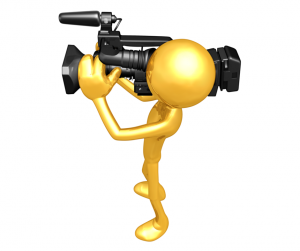 8 Ways to Get the Most Out of Videotaped Depositions
8 Ways to Get the Most Out of Videotaped Depositions
Hiring a videographer for a deposition adds expense. Here are 8 tips that will help you get the most for your money.
1. Have a neutral backdrop. Look through the videographer’s viewfinder before the deposition starts. This may help you identify distractions that aren’t obvious when you are simply sitting across from the deponent.
One of our clients shared a story about a videotaped deposition of a doctor. The deposition was held at the doctor’s office. When the videotape was played for the jury, our client was surprised when some jurors started to laugh. Only then did he realize that the jurors were being entertained by exotic, colorful fish swimming in and out of the doctor’s head. A backdrop placed over the doctor’s large saltwater fish tank would have helped keep the jury focused on the testimony.
2. Make sure the videographer and court reporter synchronize their clocks. This will make it much easier to sync the transcript to the video and to find particular sections you want to edit. Inform the reporter that you want time stamps on your transcript.
3. Synchronize your video with the deposition transcript. The lines of the transcript will be matched up with the audio and video. The jury will be able to read the testimony while watching the video. This can be helpful if you have a witness that is difficult to understand or if you have complex or technical testimony.
4. Create video clips. Too much of a good thing can be a bad thing. Don’t expect jurors to pay attention just because you are showing them a videotape. Use the transcript to identify key portions of the testimony and create short clips to present the most important points.
There are many different trial presentation software programs that can be used to create video clips (Sanction, Summation, TrialDirector, LiveNote, and Visionary to mention just a few). If you don’t have the ability to create the clips yourself, your videographer can do it for you.
Be sure to let the videographer know what equipment you will use to view the clip (Windows or Mac laptop or a DVD player). This will determine the video format you need. A DVD that plays perfectly on your laptop may not work on a DVD player. Consider hiring someone who specializes in trial presentation to assist you during trial if you are using multiple videotaped depositions and exhibits. Remember the old adage: if something can go wrong, it probably will. Be prepared!
5. Direct the movie. Coach your witnesses. They should not make unusual faces or exaggerated expressions while giving their testimony. Ask them to sit calmly in front of the camera and avoid rocking or twirling in their chair. They should keep their hands away from their faces and the microphone, and they should not tap or drum on the conference table.
Clothing should be neutral. Avoid red, white, and fluorescent clothing, as well as tight patterns and stripes. Don’t wear shiny jewelry. Be aware of plunging necklines and the camera angle.
The witness will naturally look at the person asking them questions. Typically the videographer will focus on the witness and they will be filmed in profile as they respond to the questions from counsel sitting to their right or left. If you want the witness to look directly into the camera, make sure the person asking questions is sitting next to or in front of the videographer.
6. No cell phones. This sounds like a no-brainer, but it is often forgotten. Even if a cell phone is on silent, an incoming call can interfere with the audio portion of your recording. All parties need to be reminded to turn off their phones before the deposition starts.
7. Eliminate shadows. A shadow across the witness is not particularly distracting when you are interacting with them in person. However, on video a shadow can make it difficult for the jury to focus on the testimony.
8. Hire a legal video specialist who is familiar with trial protocols and multiple format production. Yes, anyone can set up a video camera, but a videographer familiar with the standards for videotaped depositions and the duties of a legal videographer will cover the bases for you and will be available to help you with production issues after the deposition is over.
Video is a powerful tool, and if used properly it can be very compelling. However, variety is important! Don’t rely solely on video to get your point across. Transcripts, documents, photographs, and other exhibits can be powerful as well.